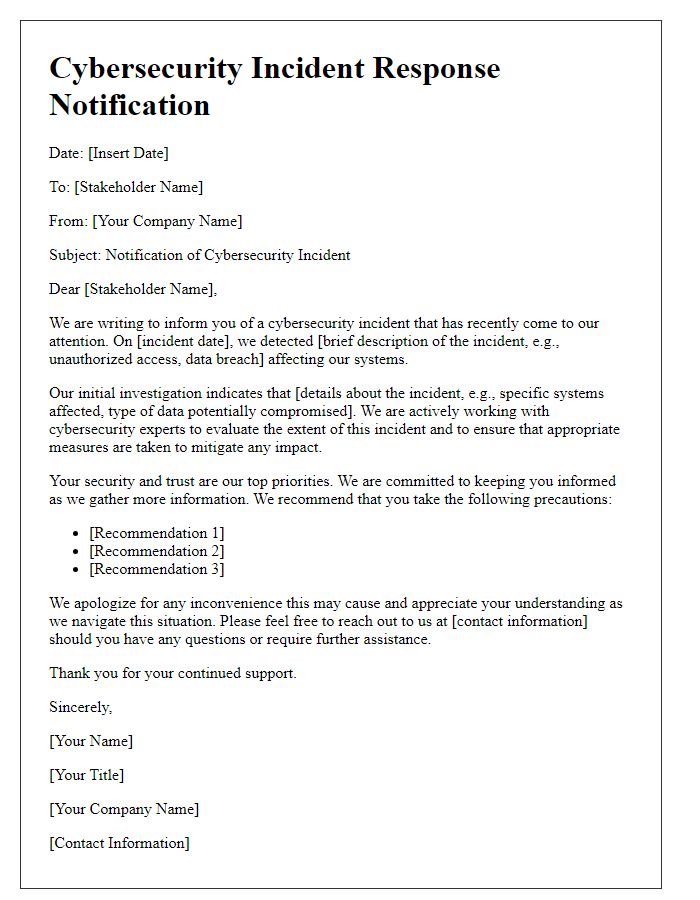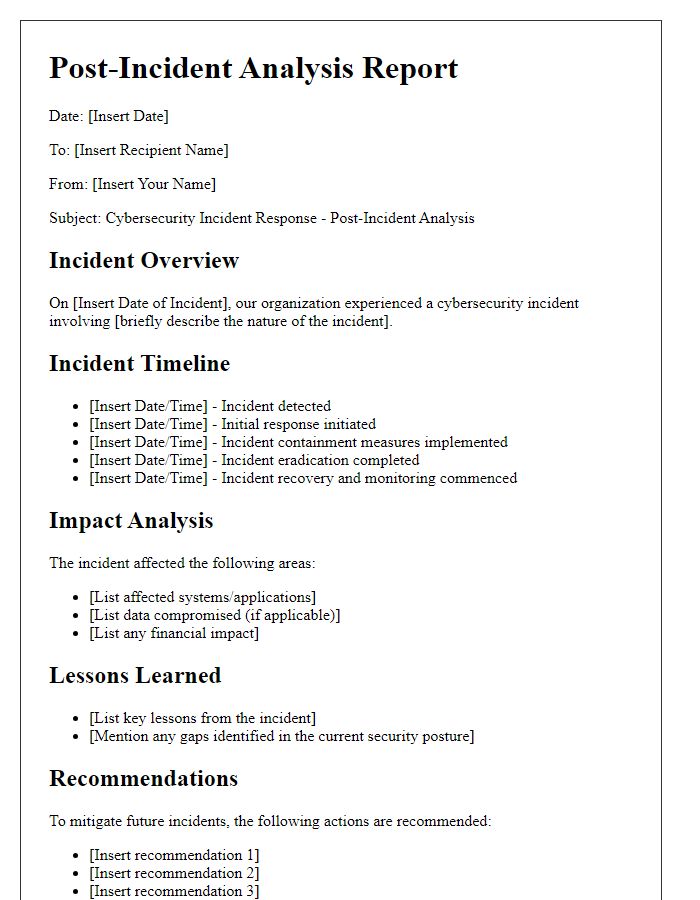In today's digital landscape, the importance of being prepared for cybersecurity incidents cannot be overstated. With threats evolving rapidly, having a clear and effective response plan is essential for protecting both your data and reputation. This article will guide you through a tailored letter template designed specifically for incident response, ensuring that you can communicate effectively and swiftly when the unexpected happens. Ready to arm yourself with the tools necessary for a proactive approach to cybersecurity? Let's dive in!

Incident Identification and Scope
Incident identification is a critical phase in cybersecurity incident response, focusing on detecting potential security breaches within an organization's digital infrastructure, such as the corporate network, endpoints, and cloud services. Accurate identification involves analyzing logs from various sources, like firewalls, intrusion detection systems (IDS), and system event logs, which can reveal unauthorized access attempts or unusual activity. Scope definition is equally vital, establishing the extent of the incident, including affected systems, data types, and geographical locations, such as servers in North America or Europe. Analyzing the potential impact on sensitive data, such as Personally Identifiable Information (PII) or proprietary business information, ensures that the response strategy effectively addresses compliance requirements with regulations like GDPR or HIPAA and minimizes damage. Collaboration between IT security teams and legal departments is essential to align actions with both technical and regulatory considerations during this phase.
Immediate Response Actions
Immediate response actions following a cybersecurity incident involve critical steps essential for mitigating damage and maintaining the integrity of organizational data systems. Identification of the incident is paramount, typically conducted by security experts using tools like intrusion detection systems (IDS) to pinpoint unauthorized access or anomalies. Containment strategies must then be employed, isolating affected networks and devices, often utilizing firewalls and segmentation techniques to prevent lateral movement by cyber threat actors. Preservation of evidence follows, where logs and forensic data are collected from compromised systems, which may include timestamps and user activity records, establishing a clear chain of events. Communication is key in crisis situations, requiring detailed reports to stakeholders, such as executives and IT departments, while informing affected individuals of data breaches, as per regulations like GDPR. Finally, an assessment of the incident's impact on sensitive information, including Personally Identifiable Information (PII), is conducted to prepare for recovery strategies and enhance future defenses against similar cyber threats.
Impact Assessment and Containment
The cybersecurity incident response process includes a critical phase known as impact assessment and containment. During this phase, organizations evaluate the extent of the breach, identifying affected systems such as servers or databases that were compromised within their network infrastructure. Potential data loss from sensitive information and customer records is calculated, determining the breach's overall severity. Containment strategies are implemented to isolate affected systems, utilizing firewalls and intrusion detection systems to prevent further unauthorized access. Additionally, endpoint security measures are upgraded across the organization to protect against malware or ransomware, ensuring that critical business operations remain unaffected. The goal is to minimize damage while preparing for recovery efforts, maintaining communication with stakeholders throughout the process.
Communication Protocols
Effective cybersecurity incident response relies on well-defined communication protocols to ensure timely and accurate dissemination of information during a security breach. Clear channels, such as secure messaging applications or encrypted emails, facilitate coordination among response teams, including IT security professionals and management. Furthermore, assigning roles and responsibilities ensures that each team member, from incident handlers to public relations officers, understands their tasks during the crisis. Regular updates must be shared, with frequency determined by the severity of the incident, so stakeholders remain informed. Additionally, post-incident debriefings provide an opportunity to refine protocols, enhancing responsiveness to potential future security threats. Proper documentation and adherence to established guidelines can significantly mitigate the impact of cybersecurity incidents.
Post-Incident Review and Lessons Learned
A post-incident review is crucial for organizations to analyze cybersecurity breaches, such as ransomware attacks or data exfiltration scenarios. This process typically occurs within the first two weeks following a significant event like the SolarWinds attack, involving cross-functional teams including IT security professionals and risk management experts. Key areas examined include the timeline of events, vulnerabilities exploited, and the effectiveness of the incident response plan. Lessons learned from incidents, such as inadequate employee training or outdated software patches, guide future prevention strategies and strengthen security protocols. Implementing changes based on these reviews, such as multi-factor authentication or enhanced firewall rules, aims to enhance overall cybersecurity posture and mitigate the risk of future incidents. Regular assessments, ideally quarterly, ensure that organizations stay vigilant against evolving threats, fostering a culture of continuous improvement and resilience in the face of cyber risks.
Letter Template For Cybersecurity Incident Response Samples
Letter template of cybersecurity incident response notification to stakeholders

Letter template of cybersecurity incident response for internal team communication

Letter template of cybersecurity incident response for regulatory compliance

Letter template of cybersecurity incident response post-incident analysis

Letter template of cybersecurity incident response engagement with law enforcement

Letter template of cybersecurity incident response educational resources for employees








Comments